You'll get the best results from solar cooking between 10:00 AM and 2:00 PM when the sun's intensity peaks. Start your morning meal prep around 9:00 AM and plan to finish evening meals by 2:00 PM for ideal cooking conditions. Position your solar cooker facing south and adjust it every 30-45 minutes to maintain consistent temperatures. For maximum efficiency, soak grains or beans overnight and use black pots to absorb more heat. Remember to monitor the UV index – you'll want a rating of 7 or higher for the most effective cooking. These fundamental tips just scratch the surface of mastering solar meal preparation.
Understanding Solar Cooking Basics
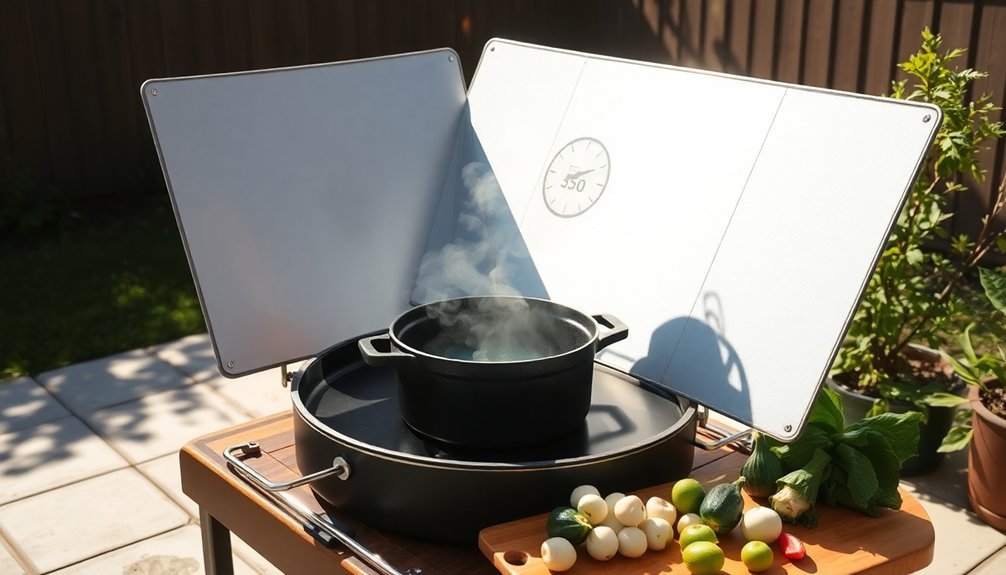
While traditional cooking methods rely on gas or electricity, solar cooking harnesses the sun's energy to prepare meals sustainably.
You'll find four main types of solar cookers: panel cookers for travel convenience, box cookers with insulated walls and glass covers, parabolic cookers shaped like satellite dishes, and tube cookers that work even in cloudy conditions.
To cook effectively, you'll need key components like reflective surfaces to concentrate sunlight and proper insulation to retain heat. Most solar ovens can reach temperatures of 400 degrees Fahrenheit.
If you're using a box cooker, look for one with a black interior that acts as a heat sink and clear glass or plexiglass covering.
Remember to adjust your cooker every one to two hours to maintain direct sunlight exposure, and always avoid looking directly at reflected sunlight to protect your eyes.
Peak Hours For Solar Meals
You'll achieve the most reliable results with your solar cooker during mid-morning hours, particularly between 10:00 a.m. and 2:00 p.m. when the sun's intensity reaches its peak.
Your cooking schedule should take advantage of this ideal window, with morning meal prep starting around 9:00 a.m. and evening meals beginning no later than 2:00 p.m. It's essential to monitor the UV index of 7 or higher for optimal cooking performance.
These peak cooking hours will shift slightly throughout the year as seasonal changes affect the sun's position and intensity in your location.
Mid-Morning Solar Success
Making the most of solar cooking starts with understanding peak sunlight hours. You'll achieve ideal results by positioning your solar oven between 10:00 AM and 3:00 PM, when the sun's intensity is strongest. To maximize your morning cooking success, set up your oven by 8:30 AM in summer months, facing south with the glass angled at 90 degrees to the sun. Black cooking pots help ensure efficient cooking by maximizing heat absorption in your solar oven.
| Time | Activity | Tips |
|---|---|---|
| 8:30 AM | Initial Setup | Position south-facing, prep ingredients |
| 10:00 AM | Prime Cooking | Start main dishes, adjust every 30-45 min |
| 11:00 AM | Peak Heat | Monitor temperatures, add quick-cooking items |
Remember to soak beans or grains overnight and use dark cookware to absorb heat efficiently. You'll need to reposition your oven throughout the morning to follow the sun's path, ensuring consistent temperatures for thorough cooking.
Seasonal Cooking Windows
Because solar cooking depends heavily on seasonal changes, understanding peak hours throughout the year is essential for successful meal preparation.
Summer offers the longest and most efficient cooking windows, while fall and spring require more careful timing. In winter, you'll need to adapt to shorter days and lower sun intensity by starting earlier and allowing for extended cooking periods. Various dishes like a 3-pound roast can be successfully prepared using only solar heat when timing is properly planned.
For best results across all seasons, plan your meals around these key considerations:
- Summer cooking thrives between 11 AM-3 PM with minimal supervision needed
- Spring and fall require more frequent adjustments during peak hours
- Winter cooking may need splitting over multiple days, focusing on 10 AM-4 PM
Always position your solar cooker to avoid shadows and adjust it regularly to track the sun's movement for maximum efficiency.
Morning Meal Planning
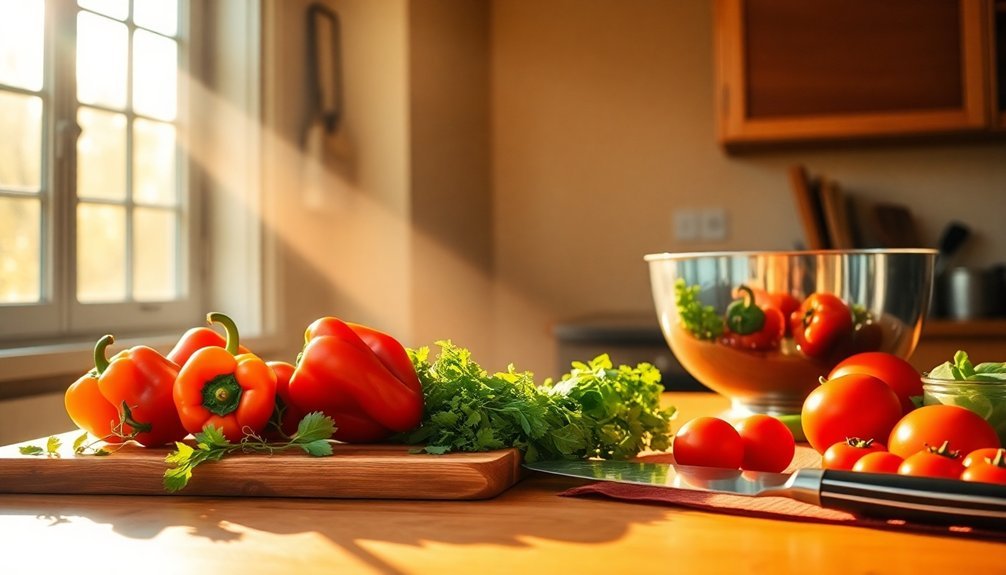
You'll find early morning meal prep most efficient when you start with quick-assembly breakfast items like overnight oats, yogurt parfaits, or pre-cut fruit.
Keep your kitchen cool during summer mornings by completing temperature-sensitive tasks before the day heats up, including baking and stovetop cooking.
Set yourself up for success by portioning ingredients, setting out cooking tools, and reviewing your meal plan before the morning rush begins.
Early Light Breakfast Options
When planning early morning meals, starting with light breakfast options can set a positive tone for your day while providing essential nutrients.
You'll find that no-cook options like yogurt parfaits with fresh berries or overnight oats offer convenience without sacrificing nutrition. For grab-and-go situations, pair a granola bar with fresh fruit or pack a half peanut butter sandwich for sustained energy.
- Blend a quick smoothie using frozen fruits, yogurt, and juice for a nutrient-packed drink you can take anywhere
- Prepare overnight oats in mason jars with your favorite toppings like nuts, seeds, and dried fruits
- Combine Greek yogurt with granola and fresh berries for a protein-rich breakfast that requires zero cooking
These light options provide balanced nutrition while keeping your morning routine simple and efficient.
Temperature Control Essentials
Maintaining proper temperature control during morning meal preparation guarantees both food safety and quality results. You'll need to verify your refrigerator stays below 40°F and your freezer at 0°F before pulling out ingredients. Check these temperatures when you start your morning routine.
While cooking breakfast, use a calibrated food thermometer to verify safe internal temperatures. For morning proteins, cook ground meats to 155°F, eggs until firm, and any poultry items to 165°F.
If you're preparing items ahead, remember that hot foods must stay above 140°F.
For make-ahead breakfast items, you'll need to cool them properly. Use shallow containers and ice baths to bring temperatures down quickly – from 140°F to 70°F within 2 hours, then to 40°F within 4 more hours.
Don't overstuff your refrigerator, as this blocks proper airflow.
Time-Saving Morning Setup
Starting your morning with an organized meal setup dramatically reduces daily stress and saves precious time.
You'll find that preparing components the night before creates a smooth breakfast routine. Set yourself up for success by dividing cooked foods into grab-and-go containers and keeping pre-portioned ingredients ready to use.
Make your mornings easier with these efficient preparation strategies:
- Prepare overnight oats or smoothie ingredients in advance, storing liquid components in ice cube trays for quick blending.
- Pack individual containers with portioned snacks like nuts, dried fruits, or homemade granola for easy access throughout the day.
- Keep a running inventory of your ingredients and organize your fridge with perishables front and center to prevent waste and simplify meal planning.
Afternoon Solar Cooking Strategy
To maximize your solar cooking success, schedule your meal preparation between 11:00 am and 3:00 pm, as this timeframe offers peak sunlight intensity and ideal cooking temperatures.
Position your solar oven facing south and adjust the reflectors to concentrate sunlight onto the cooking chamber.
You'll need to rotate your oven every one to two hours to track the sun's movement, especially during winter months.
Use dark-colored pots with lids to retain heat effectively, and remember to reduce liquid amounts in your recipes by ¼ to ½ cup.
Cast iron and granite ware work best for heat absorption and retention.
Monitor your oven's temperature to maintain 250°-400° for safe cooking.
Don't forget to protect your eyes from reflector glare and use potholders when handling hot cookware.
Weather Impact On Cooking Times
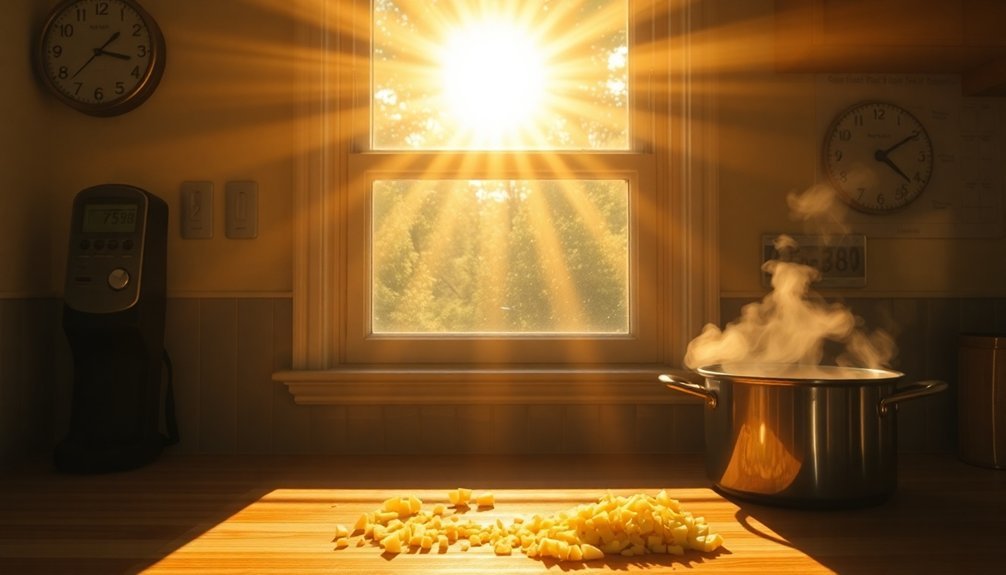
Weather plays an essential role in determining your meal's cooking time, whether you're using an outdoor grill, smoker, or conventional oven. Cold air and wind can greatly slow down your cooking process by cooling both the exterior of your cooker and the food inside.
You'll need more fuel and time when cooking in chilly conditions. Humidity levels also affect cooking speed – high humidity prevents moisture evaporation and speeds up cooking, while low humidity does the opposite.
- Insulate your smoker with a cold weather jacket or welding blanket to maintain consistent temperatures
- Use a water pan with red lava rocks to control moisture levels and enhance cooking efficiency
- Adjust cooking temperatures carefully – higher heat reduces cooking time but requires close monitoring to prevent burning
Seasonal Solar Cooking Calendar
While indoor cooking conditions remain fairly stable year-round, solar cooking success depends heavily on the sun's position and seasonal variations.
You'll find summer offers the most flexibility, with peak cooking hours from 11:00 am to 3:00 pm when the sun is directly overhead.
During fall and winter, you'll need to adapt your schedule. Start cooking earlier, around 10:00 am, to compensate for the sun's lower position and reduced UV intensity.
You'll also need to adjust your solar cooker more frequently to maintain ideal temperatures.
Plan your meals strategically: bake breads and pastries during peak hours, and reserve slow-cooking dishes for longer daylight periods.
If you're in a coastal or cloudy region, you'll want to maximize clear-sky opportunities by preparing ingredients in advance and possibly cooking in stages across multiple days.
Time Zone Cooking Adjustments
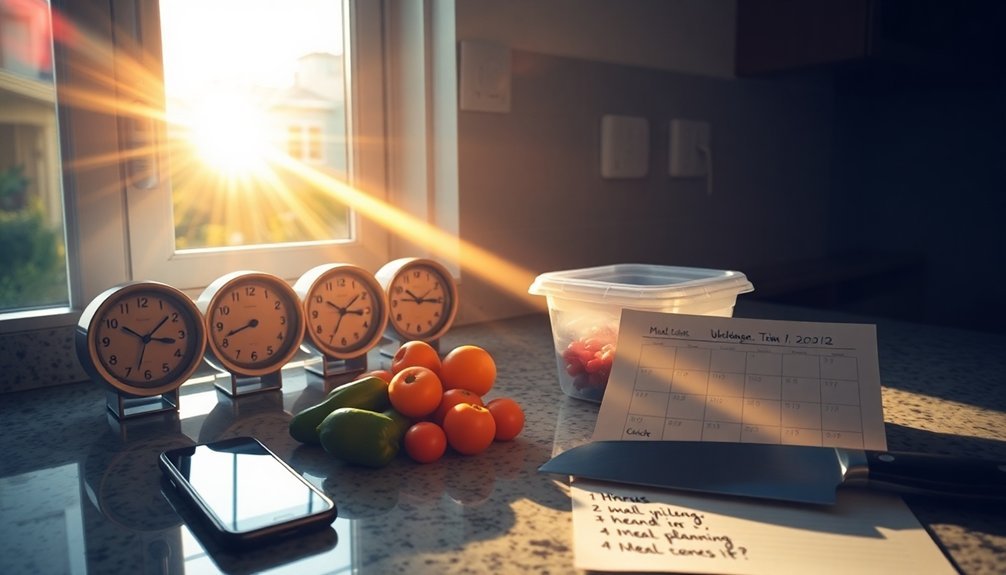
Since time zones greatly impact our internal body clock, adapting your meal preparation schedule becomes vital when traveling across different regions.
You'll need to shift your cooking times to match local schedules, which helps reset your circadian rhythm and reduces jet lag symptoms by up to half. When you align your meals with local time, you'll support healthy digestion and maintain stable energy levels throughout your journey.
- For eastbound travel, prepare and eat meals earlier than usual to match your destination's schedule
- During westbound journeys, you can gradually delay your cooking and eating times
- Include local ingredients in your meals to help your body adapt while maintaining nutritious options
Remember that consistent meal timing plays an important role in maintaining your sleep-wake cycle and supporting natural melatonin production while traveling across time zones.
Frequently Asked Questions
Can Solar Ovens Be Used Effectively in Snowy Winter Conditions?
Yes, you'll find solar ovens work well in snowy conditions when there's bright sunshine. They can reach 550°F even in 10°F weather – just adjust the angle frequently and use reflective snow to enhance cooking efficiency.
How Does Air Pollution Affect Solar Cooking Efficiency and Food Safety?
Air pollution reduces your solar cooker's efficiency by blocking sunlight, leading to longer cooking times. While it won't affect food safety directly, you'll need to guarantee proper temperature is reached despite the extended heating period.
What Backup Cooking Methods Should Be Prepared Alongside Solar Cooking?
You'll need gas stoves, electric ovens, or wood-burning grills as reliable backups for your solar cooking. Don't forget portable camping stoves and microwaves too – they're essential when weather doesn't cooperate.
Does Altitude Significantly Impact Solar Cooking Temperature and Duration?
While you'll experience slightly higher solar radiation at elevation, altitude doesn't greatly impact your cooking times. Latitude, sun angle, and cooker design matter more for determining your cooking temperature and duration.
Can Solar Ovens Be Used to Safely Preserve and Dehydrate Foods?
Yes, you can safely preserve and dehydrate foods using solar ovens if you maintain proper temperatures above 140°F, use sterilized equipment, and follow correct processing times. You'll need to monitor temperatures consistently for safety.
In Summary
You'll get the most out of solar cooking by timing your meals around peak sunlight hours, typically between 10 AM and 2 PM. Remember to adjust your schedule based on your local time zone and seasonal changes. By planning ahead and monitoring weather conditions, you'll maximize your solar cooking efficiency. Whether you're preparing breakfast, lunch, or dinner, working with the sun's natural rhythm guarantees the best results.

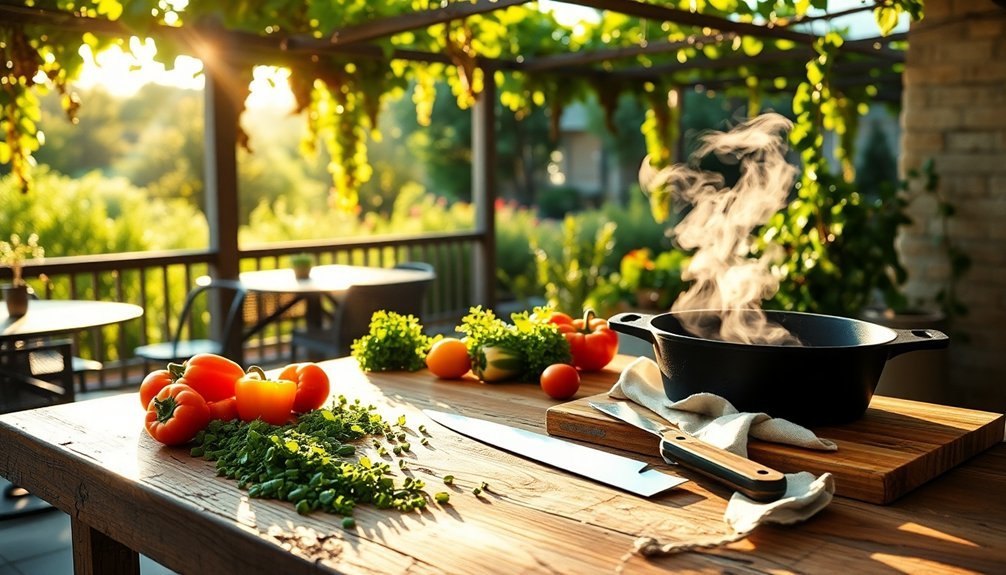



Leave a Reply